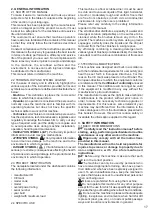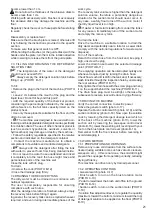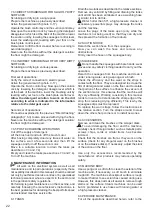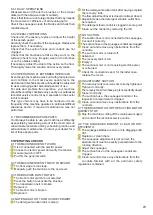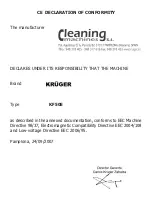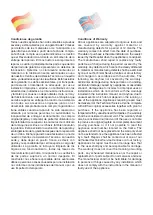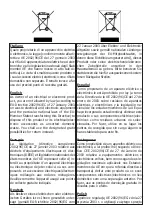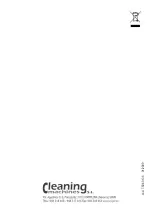
21
become lower than 1 cm.
Do not allow the thickness of the abrasive disks to
become less than 1 cm.
Working with excessively worn brushes or excessively
thin abrasive disks may damage the machine and the
floor.
Regularly check the wear on these parts before starting
to work.
Disassembly or replacement:
Make sure that the brush plate is raised; otherwise lift
it by following the instructions provided in the specific
section.
To make sure that general switch is OFF.
While holding the brushes (or the guide disks) with the
hands under the plate, turn them in the rotation direction
while lowering to release them from the guide plate.
7.3 FILLING AND DRAINING THE DETERGENT
SOLUTION TANK
The temperature of the water or the detergent
should never exceed 50°C.
Always empty the detergent solution tank before
filling it up. (PHOTO B-11)
To fill:
Remove the plug in the front of the machine. (PHOTO
A-3)
Leave 2 cm between the mouth of the plug and the
liquid level. Do not fill beyond this point!
Add the required quantity of the chemical product,
considering the percentage indicated by the supplier,
with reference to the full tank capacity listed on the
product sheet.
Use only those products suitable for the floor and the
dirt to be removed.
The machine was designed to be used with non-
foaming and biodegradable detergents made specifically
for scrubber-driers. The use of other chemical products
(such as sodium hypochlorite, oxidisers, solvents or
hydrocarbons) may damage or destroy the machine.
Follow the safety regulations specified in the relative
section and indicated on the detergent container.
Contact the machine manufacturer to obtain a
complete list of available and suitable detergents.
Always add the detergent after filling the tank
with water to prevent foam from being created inside.
Do not leave the water hose unattended and insert
it completely into the tank: the hose might move and
get sensitive parts of the machine wet.
Close the tank with its plug
To drain:
Unscrew the cock (PHOTO B-12)
Close the drainage plug firmly.
7.4 DRAINING THE RECOVERY TANK
The dirty water must be drained in accordance with
national regulations.
The user is completely responsible for ensuring
compliance with such rules.
After the detergent solution is finished, always empty
the recovery tank before filling it again.
In general, the recovery tank can be emptied whenever
required, and even during intermediate phases of the
work cycle.
The recovery tank volume is higher than the detergent
solution volume, therefore a potentially dangerous
situation for the suction motor should never occur. In
any case, a safety float turns off the suction motor if
the dirty liquid level is too high.
If water or foam starts leaking from under the tanks
for any reason, immediately turn off the suction motor
and empty the recovery tank.
To drain the tank:
Drive the machine to a suitable location to drain the
dirty water and preferably near a toilet or a sewer drain
(comply with the national regulations for waste water
disposal).
Turn off the machine.
Detach the drain hose from the hook and, keeping it
high, unscrew the plug.
Lower the drain hose toward the selected drainage
point. (PHOTO B-11)
The emptying operation can be interrupted quickly and
whenever required just by raising the drain hose.
Check how much dirt is still in the tank and, if necessary,
wash it inside through the inspection hole by unscrewing
the rear window (PHOTO B-15)
Fully tighten the drain hose with the screw plug and hang
it on the support behind the machine (PHOTO B-11)
The drain hose plug must be airtight, otherwise the
subsequent pressure loss will reduce drying efficiency.
7.5 DRIVING THE MACHINE
Verify the correct connection to electric power.
Active the general switch (photo C-17).
Operate the brush control switch (photo C-19) and the
suction control key (photo C-18). Now open the solution
cock by lowering the detergent dosage lever which is
at the back of the machine (photo B-10), lower the
suction unit by lowering the squeegee control level
(photo B-16), lower the washing unit, levering with your
foot on the brush plate control lever (photo B-14).
Remember to lift the floor cleaner before reversing to
avoid damaging it.
7.6 WORK METHOD
7.6.1 PREPARATION AND WARNINGS
Remove any loose solid residue from the surface to be
treated (using suitable tools, such as vacuum cleaners,
sweepers, etc.). It this is not done, the solid dirt might
prevent the squeegee from operating correctly, reducing
drying efficiency.
This machine can driven only by trained personnel.
7.6.2 OPERATING CONTROLS
General switch (photo C-17)
Brush switch, to turn on the brush rotation motor
(PHOTO C-19)
Pedal to raise/lower the brush unit off/on to the ground
(PHOTO B-14)
Suction switch, to turn on the suction motor (PHOTO
C-18)
Solution flow adjustment lever, to regulate the quantity
(maximum toward the bottom, minimum toward the top)
of detergent solution to be applied on the floor (PHOTO
B-10)
Содержание KF50E
Страница 2: ...FOTOGRAFIAS pag 3 PICTURES ESPANOL pag 7 ENGLISH pag 16 2 GB E ...
Страница 3: ...3 A ...
Страница 4: ...4 B ...
Страница 5: ...5 C ...
Страница 6: ...D 6 ...
Страница 28: ...cod 7 504 0136 01 2009 ...











